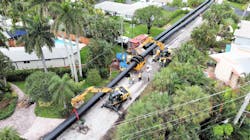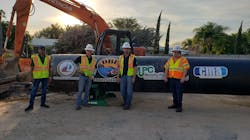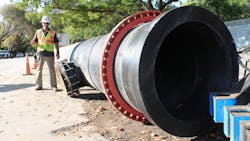Fort Lauderdale Force Main Upgrade | 2022 WWD Top Projects
Numerous main breaks and 200 million gallons of spilled sewage endangered the future of Fort Lauderdale, Florida’s tourist industry.
Located on the southeast coast of Florida, Fort Lauderdale is known for its beaches, boating canals and water recreation destinations. It hosts more than 10 million tourists annually and the failing water infrastructure posed a threat to the city’s economic future. The city declared an emergency and was awarded two design-build contracts within two months of the first break to expedite repairs.
“The City of Fort Lauderdale was dealing with aging infrastructure that due to erosion from the brackish saltwater was virtually disintegrating,” said Omar Castellon, P.E., assistant public works director – engineering for the city of Fort Lauderdale.
The primary culprit was an old force main, which the city aimed to replace with 7 miles of large diameter high-density polyethylene pipe. Due to the length of the project, it was divided into north and south sections as separate projects which separate teams would complete.
The pipe ran through the heart of downtown Fort Lauderdale, so reducing disruption to local businesses, tourists and residents was crucial to the project’s success. Approximately 6 miles of the project was installed using trenchless technology as a result.
“We knew that we needed to provide the quickest solution possible for our community, and the technology utilized allowed for the replacement of the compromised [force main] in record time,” Castellon said. “This trenchless process, coupled with the use of HDPE and its 100 plus year life span, is quite simply the best available technology out there!”
In addition to the urban location for installation, the pipe had to cross three major water ways: 1,800 feet of the Tarpon River; 2,500 feet of the New River; and 1,600 feet of the Middle river. The Tarpon crossing was installed near a bridge with only 8 feet of available right-of-way to complete the work. The pipe also reached depths of more than 60 feet at points, and due to that depth and the soil conditions for the Middle River crossing, 48-inch DR 11 pipe was used, making this one of the first projects to use this pipe size and DR in the U.S.
Horizontal directional drilling (HDD) allowed the city to install large sections of pipe at a time while also maintaining an aggressive construction schedule, with completion after only 18 months of work. In fact, two sections of the installation were longer than 3,000 feet. One used 48-inch HDPE DR 13.5 pipe while the other used 54-inch HDPE DR 17 pipe. Additionally, four HDDs were used in a tight-radius compound curved section of the pipe, which included 2,600-foot and 1,400-foot S curves.
About the Author
Bob Crossen
Bob Crossen is the vice president of content strategy for the Water and Energy Groups of Endeavor Business Media, a division of EndeavorB2B. EB2B publishes WaterWorld, Wastewater Digest and Stormwater Solutions in its water portfolio and publishes Oil & Gas Journal, Offshore Magazine, T&D World, EnergyTech and Microgrid Knowledge in its energy portfolio. Crossen graduated from Illinois State University in Dec. 2011 with a Bachelor of Arts in German and a Bachelor of Arts in Journalism. He worked for Campbell Publications, a weekly newspaper company in rural Illinois outside St. Louis for four years as a reporter and regional editor. Crossen can be reached at [email protected].




